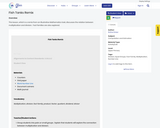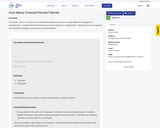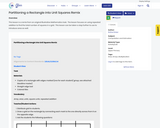
3rd Grade Multiplication Exit Ticket using Equal groups and Repeated Addition.
- Subject:
- Computation and Estimation
- Material Type:
- Activity/Lab
- Author:
- Ashley Harris
- Date Added:
- 07/25/2022

3rd Grade Multiplication Exit Ticket using Equal groups and Repeated Addition.

Water is a natural resource that is limited and needs to be conserved. Students will collect data about how much water they are using at home, design a plan to conserve water, implement the plan, and again take data to determine their success.

Description: Water is a natural resource that is limited and needs to be conserved. Students will collect data about how much water they are using at home, design a plan to conserve water, implement the plan, and again take data to determine their success.

This lesson, which is a remix from an Illustrative Mathematics task, discusses the relation between multiplication and division. Fact families are also explored.https://goopenva.org/courses/3-oa-fish-tanks

The purpose of this lesson is to help students develop their understanding of algebra using the patterns of multiplcation that occur on a hundreds board. This is an effective strategy that will help students develop an understanding of multiples which is very crucial in 4th grade and above. It also reinforces mutiplication as repeated addition. This is also an effective strategy to use with English Language Learners, Special Educational Students and struggling learners because it provides a hands-on, interactive format for the whole class to see and participate.This lesson is also very engaging and it promotes most of the 5 C's: critical thinking, creative thinking, collaboration, communication, and citizenship.Use the following sites to look at 2 products that I have used from EAI and Didax.https://www.eaieducation.com/Product/504038/Make_a_Splash%e2%84%a2_120_Mat_Floor_Game.aspx (see image)https://www.didax.com/hip-hoppin-hundreds-mat.html

This lesson, which is a remix from an Illustrative Mathematics task, models different strategies for multiplication. It emphasizes the importance of equal groups in multiplication. Students are encouraged to demonstrate strategies, using various representations.https://goopenva.org/courses/3-nbt-how-many-colored-pencils

I created this game to give my students a fun way to practice multiplication! 3rd grade students should participate in meaningful activities to develop an understanding of multiplication and become fluent with their multiplication facts. This activity supports sol 3.4c, demonstrate fluency with multiplication facts of 0, 1, 2, 5, and 10 and sol 3.4a, represent multiplication and division through 10 × 10, using a variety of approaches and models. The students make a big circle around the room and play a cakewalk style game and draw pictorial models. This game should be played after students have had experiences in the classroom working with manipulatives to practice the different approaches and strategies for multiplication. Movement is an effective way for students to learn and I can easily assess them while they play the game. My students love this game and ask to play it all the time!

Representing multiplication facts - Creating and solving multiplication problems with two whole numbers. Mathematics Instructional Plans (MIPs) help teachers align instruction with the Mathematics Standards of Learning (SOL) by providing examples of how the knowledge, skills and processes found in the SOL and curriculum framework can be presented to students in the classroom.

Multiplication Tables, free uncopyrighted image from pixabay.com

This lesson is a remix from an original Illustrative Mathematics task. The lesson focuses on using repeated addition to find the total number of squares in a grid. This lesson can be taken a step further to use to introduce area as well.https://goopenva.org/courses/2-g-partitioning-a-rectangle-into-unit-squares-2

Sequence Cardiovascular Exercises is a cross-curricular lesson designed by an Elementary Health and PE teacher to support Math and English instruction. Created By: Steve Ellison Powhatan County Public Schools